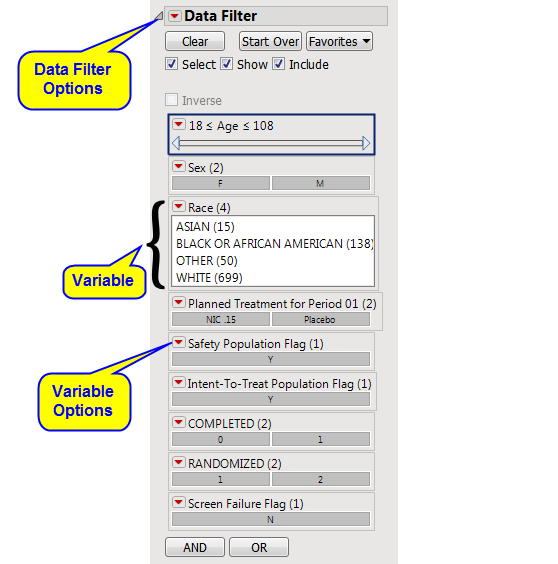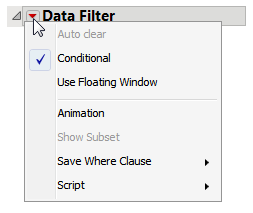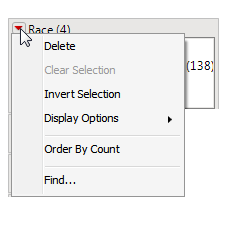Jmp How to Only Show Continuous
The Data Filter command is a JMP report that gives you a variety of ways to select, hide, or exclude subsets of data from plots and analyses. It is surfaced in many JMP Clinical reports.

The main controls in the Data Filter include the following:
: Clears all selections that you have made on variables in the Data Filter window.
: Closes the current Data Filter session and returns you to the original Data Filter window.
: Saves your current data filter criteria as a favorite. Once you have created a favorite, selecting it resets the current conditions to the criteria in the favorite. You can also remove the favorite. To retain favorites once the current session ends, save the data filter script by selecting one of the Script options from the Data Filter red triangle menu.
Select: Click the check box to show the selected rows in the data table in a highlighted state.
Show: Shows the unselected rows with the Hide icon.
Include: Shows the unselected rows with the Exclude icon.
Note: There are two additional options when filtering: Auto clear and Conditional. These options are available from the red triangle menu for the Data Filter.
Inverse: Click the check box to invert the current selection state of the rows in the data table.
Note: Only the rows in the data table are inverted, not the selection in the Data Filter. To invert the selection in the Data Filter, from the column's red triangle menu, select Invert Selection.
: Opens the Add Filter Columns list. The and operator restricts the selection. You can add variables to the filter report at any time.
: Opens the OR Add Filter Columns list. The or operator extends the selection. You can add variables to the filter report at any time.
If you modify a row state that you have set in the Data Filter and subsequently alter row states in the data table, or select points in a graph or plot, the selections in the Data Filter might not match the selections in the data table. The Data Filter contains a warning message that says: Your selection was changed in another window. The button appears. Clicking changes the data table selections back to reflect the selections in the Data Filter.

The red triangle menu next to Data Filter contains the following options:
Keeps the Data Filter window on top of its associated data table. If you do not want the Data Filter window to remain on top, deselect this option.

The Animation Controls panel (shown above) is surfaced when you select Animation. It contains the following controls:
The middle button starts and stops the animation. After you start the animation cycles, the button changes to a stop button (). By default the animation begins with the first value of the topmost variable.
The backward arrow moves the animation backward one cycle. Click more than once to go backward more than one cycle.
The forward arrow moves the animation forward one cycle. Click more than once to go forward more than one cycle.
The square button hides the Animation Controls panel on the Data Filter Window. Select Animation from the menu on the Data Filter title bar again to see the Animation Controls.
Use the slider to adjust the speed of the animation (slower to faster).
Forward: Highlights values from first to last.
Backward: Highlights values from last to first.
Bounce: Highlights forward and then backward repeatedly.
Show Subset: Creates a new data table that contains only the following:
Once you have filtered variable values in the Data Filter, that information can be expressed as a JMP WHERE clause that is to identify specific rows of data for processing or analysis. The Data Filter builds a WHERE clause based on the value selections that you make.
to Clipboard: Creates a WHERE clause from the filter criteria and puts it on the clipboard.
to Row State Column: Creates a row state column in the data table that has a formula equivalent to the filter criteria.
to Data Table: Creates a WHERE clause from the filter criteria and saves it as a JSL command with the current data table in a table property called Filter.
to Script Window: Creates a WHERE clause from the filter criteria and appends it to the current script text window, or creates a new script if one does not exist already.
to Journal: Creates the WHERE clause from the filter criteria and appends it to the current journal, or creates a new journal if one does not already exist.
Script: Provides options for saving scripts. Red Triangle Options for Variables

List Display shows each level as a member of a list, followed by its frequency.
Clear Find clears the results of the Find operation and returns the window to its original state.
Match Case uses the case of the search string to return the correct results.
Contains searches the data for values that includes the search string.
Does not contain searches the data for values that do not include the search string.
Starts with searches the data for values that start with the search string.
Ends with searches the data for values that end with the search string.
gopinkoprimsequiew.blogspot.com
Source: https://www.jmp.com/support/downloads/JMPC61_documentation/report_selector/PR_L_UT_0028.html
0 Response to "Jmp How to Only Show Continuous"
Post a Comment